
The United States Naval Special Warfare Command (USNSWC), also known as NAVSPECWARCOM and WARCOM, is the naval component of United States Special Operations Command, the unified command that oversees and conducts the nation's special operations and missions.

Patrol Boat, Riverine, or PBR, is the United States Navy designation for a small rigid-hulled patrol boat used in the Vietnam War from March 1966 until 1975. They were deployed in a force that grew to 250 boats, the most common craft in the River Patrol Force, Task Force 116, and were used to stop and search river traffic in areas such as the Mekong Delta, the Rung Sat Special Zone, the Saigon River and in I Corps, in the area assigned to Task Force Clearwater, in an attempt to disrupt weapons shipments. In this role, they frequently became involved in firefights with enemy soldiers on boats and on the shore, were used to insert and extract Navy SEAL teams, and were employed by the United States Army's 458th Transportation Company, known as the 458th Sea Tigers.

In the Vietnam War, the Mobile Riverine Force (MRF) (after May 1967), initially designated Mekong Delta Mobile Afloat Force, and later the Riverines, were a joint US Army and US Navy force that comprised a substantial part of the brown-water navy. It was modeled after lessons learned by the French experience in the First Indochina War of Dinassaut and had the task of both transport (of soldiers and equipment) and combat. The primary land base was at Đồng Tâm Base Camp, with a floating base which operated in the major rivers of the Mekong Delta. Soldiers and sailors went out in river boats from the floating base to assault the Viet Cong. During part of the 1968-69 period, there were two such mobile bases operating in different parts of the Delta, Mobile Riverine Groups Alpha and Bravo. The MRF played a key role in the Tet Offensive.

Operation Sealords was a military operation that took place during the Vietnam War.

A brown-water navy or riverine navy, in the broadest sense, is a naval force capable of military operations in littoral zone waters. The term originated in the United States Navy during the American Civil War, when it referred to Union forces patrolling the muddy Mississippi River, and has since been used to describe the small gunboats and patrol boats commonly used in rivers, along with the larger "mother ships" that supported them. These mother ships include converted World War II-era mechanized landing craft and tank landing ships, among other vessels.
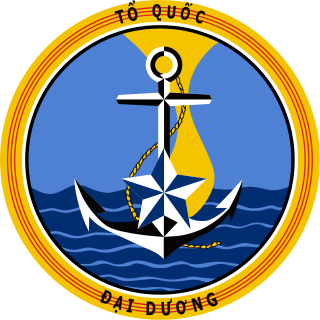
The Republic of Vietnam Navy (RVNN; Vietnamese: Hải quân Việt Nam Cộng hòa - HQVNCH; was the naval branch of the South Vietnamese military, the official armed forces of the former Republic of Vietnam from 1955 to 1975. The early fleet consisted of boats from France; after 1955, and the transfer of the armed forces to Vietnamese control, the fleet was supplied from the United States. With American assistance, in 1972 the VNN became the largest Southeast Asian navy and, by some estimates, the fourth largest navy in the world, just behind the Soviet Union, the United States and the People's Republic of China, with 42,000 personnel, 672 amphibious ships and craft, 20 mine warfare vessels, 450 patrol craft, 56 service craft, and 242 junks. Other sources state that VNN was the ninth largest navy in the world. The Republic of Vietnam Navy was responsible for the protection of the country's national waters, islands, and interests of its maritime economy, as well as for the co-ordination of maritime police, customs service and the maritime border defence force.

Armored Troop Carriers (ATC), often called Tangos from the phonetic alphabet for T, were LCM-6 landing craft modified for riverine patrol missions. They were used by the Mobile Riverine Force (MRF) of the United States Army and Navy in the Vietnam War. They were also used by Republic of Vietnam Navy (RVNN) and Khmer National Navy.

Operation Game Warden was a joint operation conducted by the United States Navy and South Vietnamese Navy in order to deny Viet Cong access to resources in the Mekong River Delta. Game Warden and its counterpart Operation Market Time are considered to be two of the most successful U.S. Naval actions during the Vietnam War.

USS Garrett County (LST-786) was an LST-542-class tank landing ship built for the United States Navy during World War II. Named after Garrett County, Maryland, she was the only U.S. Naval vessel to bear the name.
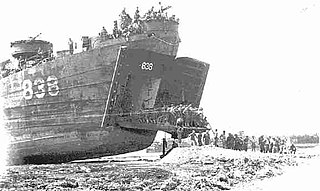
USS Hunterdon County (LST-838) was an LST-542-class tank landing ship built for the United States Navy during World War II, and later reconfigured and recommissioned for riverine warfare during the Vietnam War. Named after Hunterdon County, New Jersey, she was the only U.S. Naval vessel to bear the name.
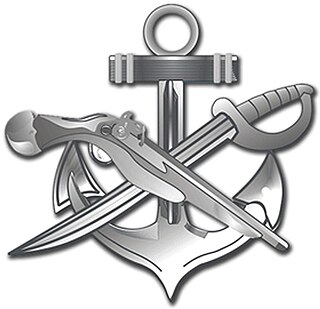
The Special Warfare Combat Crewmen (SWCC ) are United States Naval Special Warfare Command personnel who operate and maintain small craft for special operations missions, particularly those of U.S. Navy SEALs. Their rating is Special Warfare Boat Operator (SB).
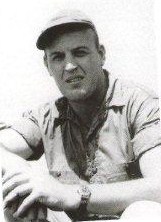
Phil Hinkle Bucklew was a professional American football player who went on to become a United States Navy officer. He served in one of the Navy's first special warfare units during World War II. While serving in the European Theater, he was twice awarded the Navy Cross, the second highest decoration in the United States Military.
The action of 1 March 1968 was a co-ordinated attempt by four North Vietnamese trawlers to resupply the Viet Cong and the efforts of Operation Market Time elements to stop them during the Vietnam War. On 28 February 1968, United States Navy SP-2H Neptune aircraft on routine patrol detected a North Vietnamese SL class naval trawler heading towards the South Vietnamese coast from north of the DMZ. By the next morning, three more trawlers were discovered and units of Operation Market Time were deployed for a surprise interception. The suspect trawlers did not fly flags so it was not until the start of the engagement that their origin was discovered. The trawlers were steel-hulled vessels, 100 feet long and armed with 57-millimeter recoilless rifles and machine guns. All four vessels were loaded with weapons and ammunition intended to be delivered to the Viet Cong. American and South Vietnamese forces that engaged in action included the United States Coast Guard cutters Androscoggin, Point Grey, Point Welcome, Winona, Point Grace, Point Hudson, Point Marone, the swift boats USS PCF-18, USS PCF-20, USS PCF-42, USS PCF-43, USS PCF-46, USS PCF-47 and USS PCF-48, two South Vietnamese navy junks and one patrol boat. Two U.S. Army helicopter gunships also participated in combat as well as aircraft used to fire flares.

USCGC Point Cypress (WPB-82326) was an 82-foot (25 m) Point-class cutter constructed at the Coast Guard Yard at Curtis Bay, Maryland in 1961 for use as a law enforcement and search and rescue patrol boat. Since the Coast Guard policy in 1961 was not to name cutters under 100-foot (30 m) in length, it was designated as WPB-82326 when commissioned and acquired the name Point Cypress in January 1964 when the Coast Guard started naming all cutters longer than 65-foot (20 m).

The Khmer National Navy was the naval component of the Khmer National Armed Forces (FANK), the official military of the Khmer Republic during the Cambodian Civil War between 1970 and 1975.
VAL-4 was a Light Attack Squadron of the U.S. Navy. Established on 3 January 1969, it was disestablished on 10 April 1972.

Nhà Bè Base is a former U.S. Navy and Republic of Vietnam Navy (RVNN) base in Nhà Bè District in Saigon of Vietnam now used as a base by the Vietnam Coast Guard.
Nam Can Naval Base is a former Republic of Vietnam Navy (RVNN) and United States Navy in the town of Năm Căn, Cà Mau province in the extreme south of Vietnam.
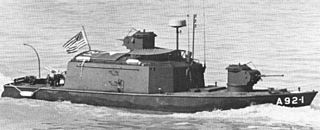
The Assault Support Patrol Boat (ASPB) (also known as the Alpha Boat), was a heavily armed and armored riverine patrol boat developed by the United States Navy for use in the Vietnam War from late 1967.
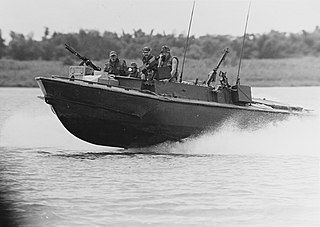
The Strike Assault Boat (STAB) (also known as the SEAL Team Assault Boat), was a fast and heavily armed riverine assault boat developed by the United States Navy for use in the Vietnam War in 1970. The mission of the STAB was nighttime Waterborne Guard Post duty (WBGP) and daylight troop/SEAL platoon insertion and extraction operations in the Mekong River and Grand Canal areas of South Vietnam.
















